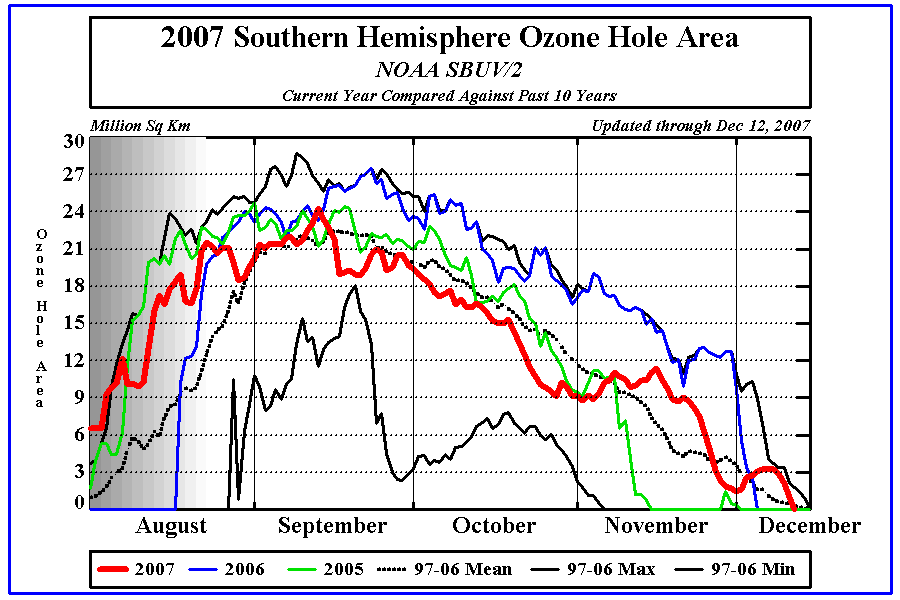Steven Goddard
Watts Up With That?
June 30, 2010
We have been hearing a lot about how the decline in Arctic ice is following the “steepest slope ever.” The point is largely meaningless, but we can have some fun with it. The Bremen Arctic/Antarctic maps are superimposed above, showing that ice in the Antarctic is at a record high and growing at the “steepest slope ever.” You will also note that most of the world’s sea ice is located in the Antarctic. But those are inconvenient truths when trying to frighten people into believing that “the polar ice caps are melting.”
There are several favorite lines of defense when trying to rationalize away the record Antarctic ice.
1. It is the Ozone Hole – which is also the fault of evil, American SUV drivers. That is a nice guilt trip, but sadly the Ozone Hole doesn’t form until August and is gone by December. Strike one.

The next one is to point out that some regions of the west side of the tiny Antarctic Peninsula have been warming. Never mind that the Antarctic Peninsula is an active volcanic ridge, and that the waters around it have not shown any significant warming. Strike two.
UAH shows Antarctica cooling slightly over the last 30 years.
The third favorite line of defense is to argue that “we expected Antarctica to warm more slowly because of the mass of the southern oceans.” Nice try – “slower warming” is not the same as “cooling.” Strike three.
(The AGW view of Antarctica is every bit as irrational as FIFA’s stand that not having instant replays somehow helps the referees’ reputations.)
On to the Arctic. First graph is a JAXA comparison of 2006, 2007 and 2010. Note that 2006 and 2007 were nearly identical, until early July. The main difference between 2006 (second highest in the JAXA record) and 2007 (lowest in the JAXA record) was that strong southerly winds compacted and melted the ice in 2007. As you can see below, the summer extent numbers are nearly meaningless before July/August. So far, 2010 is tracking very closely with both 2006 and 2007, and it appears the three will intersect in about a week.
Let’s take a closer look at the mechanisms using the PIPS ice and wind data. If we watch the movement of Arctic ice during the summer, we can see that when the winds blow away from the pole (i.e. from the north) the ice expands. When the wind blows from the south, the ice contracts. Some summers, the winds alternate between north and south, and the ice extent changes less during the summer – like in 2000 below.
Other years, like 2007, the summer winds blew consistently from the south, causing the ice to melt at a faster pace and compress towards the north.
So basically, it is weather (wind) rather than climate which controls the summer minimum. Of course, it is harder to compress and melt thick ice than thin ice – so the thickness of the ice is important. It is too early to determine if 2010 will see winds like 2007, or if summer winds this year will be more like 2006.
No one has demonstrated much skill at forecasting winds six weeks in the future, so it is really anybody’s guess what wil happen this summer. Before August arrives, the pattern should be clear.
The video below shows ice movement near Barrow, AK over the past 10 days.
The winds were blowing strongly and contracting the ice edge until the last few days, when they died down. Over the past two or three days, the ice edge has not moved very much.
Over the last week, almost all of the ice loss in the Arctic has been in the Hudson Bay, as seen in the modified NSIDC image below in red. The Hudson Bay is normally almost ice free in September, so the recent losses are are almost meaningless with respect to the summer minimum.
The modified NSIDCimage below shows ice loss since early April. All of the areas shown in red are normally ice free in September.
The modified NSIDC image below is a comparison of 2010 vs 2007. Areas of red had more ice in 2007. Areas of green have more ice in 2010.
The modified NSIDC image below shows the current deficiencies in red. Again, all of those areas are normally ice free in September, so they don’t tell us much about the summer minimum.
Below is my forecast for the remainder of the summer.
But it all depends on the wind.
From the 9th century to the 13th century almost no ice was reported there. This was the period- of Norse colonization of’ Iceland and Greenland. Then, conditions worsened and the Norse colonies declined. After the Little Ice Age of 1650 to 1840 the ice began to vanish near Iceland and had almost disappeared when the trend re versed, disastrously crippling Icelandic fisheries last year.
The thick ice that has for ages covered the Arctic Ocean at the pole has turned to water, recent visitors there reported yesterday. At least for the time being, an ice-free patch of ocean about a mile wide has opened at the very top of the world, something that has presumably never before been seen by humans and is more evidence that global warming may be real and already affecting climate. The last time scientists can be certain the pole was awash in water was more than 50 million years ago.
Is it possible that the IPCC is trying to rewrite the history books?